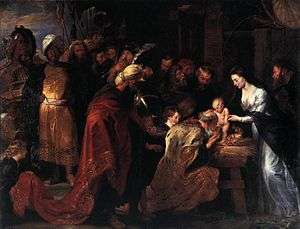Adoration of the Magi (Rubens, Lyon)
 | |
| Artist | Peter Paul Rubens |
|---|---|
| Location | Museum of Fine Arts, Lyon |
- For other treatments of this subject by the same artist, see Adoration of the Magi (Rubens).
The Adoration of the Magi is a c.1617-18 painting by Peter Paul Rubens. It is now in the Musée des Beaux-Arts de Lyon[1]
Since it is horizontal rather than vertical it was probably commissioned for a private collection rather than as an altarpiece. Peter C. Sutton suggested that, as Rubens' treatments of this subject in vertical formats were for known ecclesiastical commissions as altarpieces, the horizontal format, which is shared with Rubens' Adoration painted for the Statenkamer of Antwerp's town hall, c. 1608-09, might suggest that the Lyon painting was also a secular commission.[2] Rubens made a considerable fortune via the painting's reproduction in engravings and tapestries.
The painting arranges full-length figures across the canvas, backed by a frieze-like crowd showing a variety of mature male types, twelve in all. The oldest magus kneels and kisses the foot of the Christ Child with a tender gesture, as the Child, standing on a straw-strewn table, where he is presented by the Virgin Mary,[3] touches the magus' bald head in a gesture of benediction. The dim stable is lit by shafts of light.
References
- ↑ Inv. A.118.
- ↑ Peter C. Sutton, in Peter C. Sutton, Marjorie E. Wieseman, Nico van Hout Drawn by the brush: oil sketches by Peter Paul Rubens (exhibition catalogue) 2004: 109.
- ↑ Julius S. Held observed that Rubens in his innovative treatments of the Adoration invariably represented Mary as a symbol of Ecclesia, actively presenting the Child. (Julius Held, The Oil Sketches of Peter Paul Rubens. A Critical Catalogue (Princeton, 1980), vol. I, pp 451, 456, noted by Sutton 2004:109).
- (French) Catalogue entry
